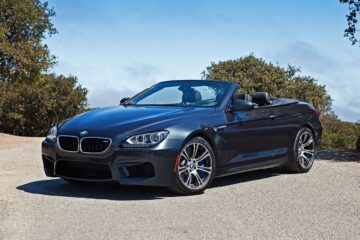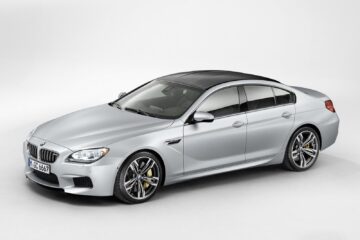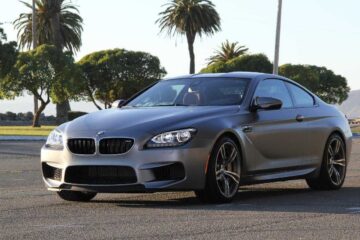Of all the cars developed under the oversight of Chris Bangle – BMW Group Design Director – this high-performance variant of the BMW M6 E64 series is the standout. Stepping up to the ferocious 500 horsepower engine, you get the sense that the BMW M6 V10 has a sultry aggression that is clumsy but beautiful.
BMW present the third generation of the BMW 6 Series. Yes not a simple one, but a high-tech one, developed by the sports division of the German automaker. Yes, we are talking about the BMW M6, which first looked at “this world” back in 1983 (E24).
But then, in 1989, Munich took a “compensatory vacation” and returned to the M6 project (E63 / E64) only in 2005, only to close again in the summer of 2010, having sold over the previous five years 9 thousand cars in the “coupe” body and 5 thousand convertibles.
M5s have always been much more popular than M6s. Being the first of the new generation of M cars, it was the M5 that initially grabbed all the laurels for itself. When the M6 debuted, it didn’t generate much excitement beyond fans of the brand and the 6 Series.
And very few people were willing to pay 1,730,000 rubles for the new E63 M6 Coupe when it was new, or 2,154,000 rubles for the M6 Convertible. This is what the statistics tell us. Only 950 M6s were sold in Russia, which is a tiny fraction of the number of M5s sold.
Today, the M6 is often derided as ugly, brash and generally not as desirable as the M5. But it’s time to restore the balance in favor of the M6.
Appearance
First off, it really is a better driver’s car. It’s stiffer, lighter and roomier than the M5, and it also has a pretty cool CSL-style carbon fiber roof fin element. Obviously the Cabriolet doesn’t get it, but the car’s roof is pretty neat on its own and folds down in less than 20 seconds. “The ‘6’ also has a superior interior compared to the M5.
The body of the auto is properly proportioned, offering sleek lines without the appearance of a chopped Mercedes CLS top.
BMW has unveiled a pretty extensive styling revision of both the E63 M6 coupe and the E64 M6 coupe.
They include a completely unique front fascia design that contains large air intakes instead of fog lights, sculpted side panels and M-design side mirrors (with black underside), and a much more aggressive rear bumper design that includes a center diffuser and flaps that wrap around each pair of dual exhaust tips.
The unique rear bumper is supported by carbon fiber supports that reduce weight. The M6 coupe is additionally equipped with one final (and significant) weight-saving feature: a carbon fiber roof panel that saves almost 50 kilograms, compared to the steel version used on other E63 models. Finally, there are three “M6” badges on the exterior: one on the trunk lid and one embedded in the chrome trim line on each fender panel.
Interior
The interior of both the E63 M6 Coupe and BMW M6 Cabrio features a 381 mm diameter 3-spoke M steering wheel with tri-color M stitching on the rim, an “M” button on the right spoke and prominent paddle shifters (only on SMG-equipped cars).
M sports seats in exclusive Merino leather with power-adjustable side bolsters and the “M” logo on both front headrests.
The center console is adorned with an optional M head-up display showing vehicle speed, engine speed and gear selection
- Illuminated center shift console with additional buttons around the transmission lever to control power mode, DSC mode, EDC mode and various DRIVELOGIC shift algorithms
- M illuminated sill plates with “M6” logo
- Driver’s footrest
- M Design – Anthracite fabric or alcantara lining (M6 Coupé only)
- Three types of M6 interior trim (carbon fiber, Madera walnut or natural olive ash wood)
The 2008 BMW M6 offered two types of Merino leather upholstery in the E63 M6 coupe and E64 M6 convertible: extended and full. The extended Merino leather included only the seat leather, the center door panels (including armrests) and the center armrest.
The BMW M6 interior is available in three colors: Black, Silverstone II and Light Sepang Bronze. A full Merino leather interior was offered as an option, and in addition to the leather interior elements included in the standard extended leather trim, it was added in the following areas: upper instrument panel (including dashboard cover), lower instrument panel (including glove compartment), upper door panels, lower door panels and center console. Comlpete Merino leather was available in five colors: black, silver II, Sepang light bronze, Indianapolis red and brown.
Engine
About the BMW M6 engine, allow us a little bit of history.
The 500 horsepower motorsport inspired V10 that blessed the BMW M6 over a decade ago was a true innovation for BMW at the time. A ruthless gasoline absorber, atmospheric and totally intoxicating, it’s crude old-school stuff, though the decline of atmospheric-engined cars isn’t apparent in today’s world. As it happens, when fitted to the 6 Series it created a monster – the BMW M6. But first, the M5.
The 2004 E60 generation M5 was born ahead of its time with an intake control system that could accelerate the 1755 kg luxury sedan from 0-100 kilometers per hour in a staggering 4.7 seconds, and once the electronic top speed limiter was removed – rising to an almost unheard of 260 km/h.
A year later, the 2006 BMW M6 was released, bringing with it the E64 convertible shortly thereafter. This new generational step saw the M6 borrow the world-class powertrain of the M5, which housed the V10 transmission and SMG. BMW then put all of this into the M6 body, which was now lower and lighter (by 120 kg), and much more visually sleek. All these improvements reduced the 0-100 time by 0.1 seconds, and while top speed remained limited to 155mph, acceleration was blistering. It was then the German brand’s fastest production car to date.
As with all cars developed by the BMW M division, performance is the motto, and the M6 is the result of the BMW M6’s peak performance. Car and Driver magazine recorded acceleration from 0 to 100 in just 4.1 seconds. Although the top speed is electronically limited to 250 kilometers per hour.
Under the hood of the BMW M6 Coupe / BMW M6 Convertible is the same engine as in the sedan M5 “last assembly” – 4, 4-liter V8 with twin turbines. It produces “on the mountain” 560 hp of maximum power in the range from 5750 to 7000 rpm; its maximum torque is 680 Nm (at 1500-5750 rpm). All power from the powertrain is transmitted to the rear wheels via a 7-speed M-DCT dual-clutch robotized transmission with an active differential. The car is also equipped with a 6-speed manual transmission for the European market.
The dynamics of the new BMW M6 are on the level. The coupe is able to overcome the speed barrier from zero to one hundred in 4.2 seconds, the convertible accelerates from a place to 100 km / h in 4.3 seconds. At the same time, the top speed of the M6 in both cases is limited to 250 km / h. Those who want even more speed can order the car with the optional “M Driver’s” package, which allows the car to accelerate up to 305 km / h.
Although the previous-generation BMW M6 lineup features a V10 engine, while the new one packs a V8, the latter is 10 percent more powerful.
True, not everyone likes the sequential SMG gearbox, but you have petals to ease the frustration. And the DSC stability control system can be switched in three modes from “safe” to “I’m about to show you something like this” to give yourself varying degrees of perception of this car.
Does it feel faster than the M5?
No. The statistics on paper tell you that it does (the M6 beats the M5 to 100 kilometers per hour by just 0.1 seconds less: in 4.6 seconds), but in reality you’ll have a hard time feeling the benefit of that advantage.
Electronics
Standard equipment includes six airbags, cornering brake control (CBC), dynamic brake control (DBC), automatic stability control and traction control, dynamic stability control (DSC), with MDynamic mode.
As well as adaptive headlight control system, xenon headlights, automatic headlight activation, headlight washer system, Isofix child seat anchorages, parking sensors, rain sensors, puncture warning system, multifunction steering wheel with SMG paddles and M Drive control, sports seats with electronic driver’s seat angle adjustment and memory function, i-Drive, head-up display with certain M functions (rev counter range, speed reading, gear selection and gearshift indication),
You think that’s it? No!
Heated front seats, extended Merino leather upholstery, automatic air conditioning, carbon fiber interior trim, trip computer, auto-dimming rearview mirror, cruise control, power adjustable seats, power front windows, power adjustable steering column, CD stereo, Hi-Fi LOGIC 7 system with 10 speakers, split-screen satellite navigation, six-disc CD changer, extended voice control and dual-sided luggage compartment mat.
Features
But you ask us, “The BMW M6 is just a two-door M5, isn’t it?”
And, yes and no. “Yes” because the M6 uses the same brilliant 5.0-liter V10 engine and still has 500 hp and more than 500 Newtons per meter of torque, which is sent to the rear wheels via a sequential manual or automatic seven-speed transmission.
“No,” because there are some important changes. For example, the M6 boasts an expensive carbon fiber roof, an all-new dashboard architecture and is 80 kg lighter than its sedan-based stablemate, 1,785 kg, playing off the M55’s 1,855 kg.
But in the world of the M, not everything is perfect. BMW iDrive’s unintuitive controls have been a stumbling block for fans of the brand for so long that it seems pointless to take another turn.
So we won’t point out the stupidity of a system so complex that the company from the factory puts a sticker on the console to help you find the air conditioning, or that forces you to analyze several layers of electronic menus in order to adjust the music.
Options
BMW M released one global special edition of the E63 M6 coupe, which was known as the M6 Competition Edition. This version was offered in most markets outside of North America in a limited edition of 100 copies (although only 63 were eventually produced). Canada also received 10 copies of its customized M6 Coupe Competition Edition, although this model was cosmetically different from the version sold in other markets.
BMW Individual has also produced two editions of the M6 with Ruby Black metallic paint and Merino leather trim in Golden Brown: the first was the production of 50 E64 M6 Convertibles, offered exclusively thanks to the collaboration between BMW of North America and Neiman Marcus stores during the end of 2006. Then, at the beginning of 2008, 25 additional examples were produced, both coupe and convertible, especially for BMW Russia.
What distinguishes both the BMW Individual Neiman Marcus Limited Edition M6 and the BMW Individual Russia Edition M6?
In partnership with BMW of North America, the company has produced a limited edition of 50 identical E64 M6 convertibles of the Neiman Marcus edition.
BMW has received individual paint and upholstery. Each of the vehicles was painted in the metallic color BMW Individual Ruby Black and fitted with BMW Individual Gold Brown leather interior with merino leather trim and BMW Individual Piano Black interior trim.
In addition, each “exhibit” was equipped with Comfort Access, Head-Head Display, HD Radio and Satellite Radio. The last feature of this edition was a unique hood with two distinct convex “precision lines” (later fitted on the E63 M6 Coupe Competition Package and Competition Edition models).
What sets the E63 M6 Coupe Competition Edition apart?
Introduced at the 2009 Frankfurt Motor Show, the E63 M6 Competition Edition combines the mechanical enhancements of the optional Hot Lover’s Package (modified suspension, wider wheels with R-compound tires, calibrated Dynamic Stability Control and M differential) with BMW Individual Frozen Grey color and a choice of two BMW Individual interior trim options: Black Merino leather with contrast stitching in light gray or Bi-Color Black + Silverstone full Merino leather with the same stitching in light gray.
In addition, each car was equipped with special Silverstone-finished anthracite mats, sill plates with “M6 Competition” lettering and a numbered plaque just above the rearview mirror. Like all M6 coupes equipped with the Competition Package, the Competition Edition hood featured a pair of convex lines on the hood.
Although BMW M announced that the Competition Edition would be limited to 100 individually numbered units, in fact only 63 M6 Competition Edition coupes were produced between July 2009 and July 2010: 54 left-hand drive, ECE-spec examples (EH91) , 8 right-hand drive.
Difference between restyling and prerestyling
What catches the eye. The steering wheel is the same three-spoke thickness as the M5, but seems lighter, turning with less resistance than the M5. The suspension – still three-way adjustable – is also a little stiffer, while the seven-speed semi-automatic shift program has been noticeably recalibrated.
The new BMW M6 is larger than the old one. But that doesn’t mean it’s put on weight. On the contrary, it has lost weight. For this, however, it was necessary to make the roof of the coupe from carbon fiber-reinforced plastic (CFRP), and in the convertible – the cover for the folding top from a special composite material based on fiberglass (SMC). Both versions get aluminum doors and hood, as well as front fenders made of lightweight thermoplastic. As a result, the curb weight of the BMW M6 Coupe is 1,850 kg, while the BMW M6 Convertible has a curb weight of 1,980 kg.
To make the standard 6-Series chassis into a high-tech “M-Series” sports car, BMW M Division engineers reconfigured the suspension, used Servotronic variable-effort steering (three modes of behavior), and put on “stronger and faster” brakes.
For the first time, Bavaria Motors used a combination of so-called carbon-ceramic brakes (M Carbon-Ceramic) with 20-inch wheels made of lightweight metal alloy, which allowed them to lose about 20 kilograms. However, this equipment variant is only available as an optional extra. The BMW M6 is fitted with 19-inch alloy wheels as standard.
What else makes the sporty M-Series different from the standard BMW 6-Series? Obviously, the aerodynamic dodger, which looks a bit more refined on the third-generation car. It includes new bumpers, moldings along the sills and modified exhaust system tailpipes – two tips on each side. At the front, the car features a new radiator shape that modestly colors the “M6” shield. There was no such thing in the lineup of the previous generation BMW M6.
The interior of the BMW M6 is a “derivative” of the standard model, with familiar details for the M-package. These include new sports seats with new upholstery, plus redesigned steering wheel, instrument panel and drive selector.
Bottom line
Without a doubt, the M6 is a high-speed luxury car that will gobble up long distances without fuss. And if BMW only did that with a six-speed manual transmission or a conventional automatic, we’d say the car was worth every penny of its “M” sticker.
In its current form, the M6 is a brilliant success when you take into account the unusual body design. The chassis and engine specs are a clear demonstration of just how flamboyant BMW can be. But if you want to relax, tune the radio or take a cup of coffee with you without thinking twice, there are cars that cost a quarter less and do the job much better.
Generations and configurations
Generation 2
03.2005 – 06.2010
| 5.0 AMT | S85B50 | 5.0L | 507 hp |



0 Comments